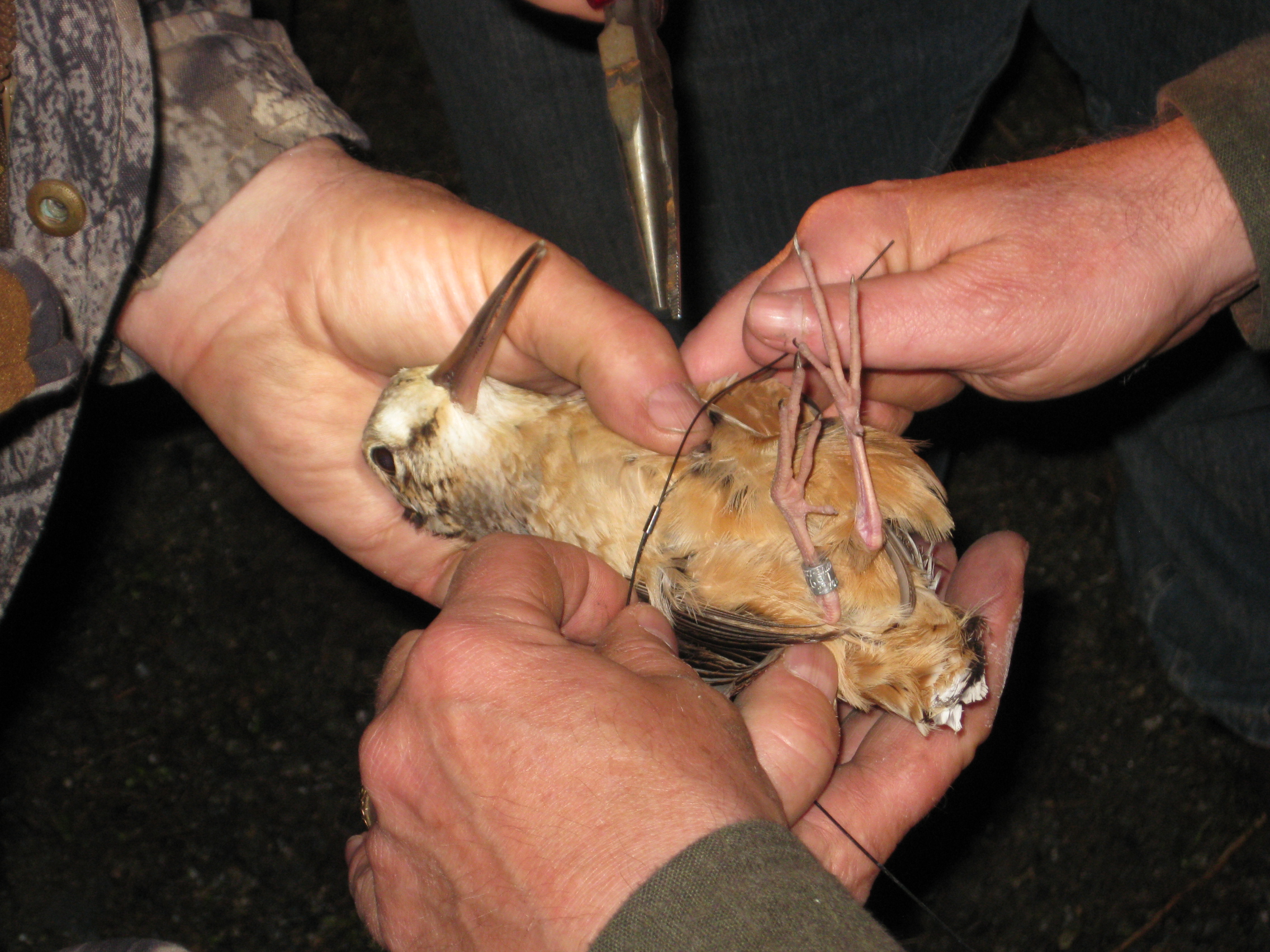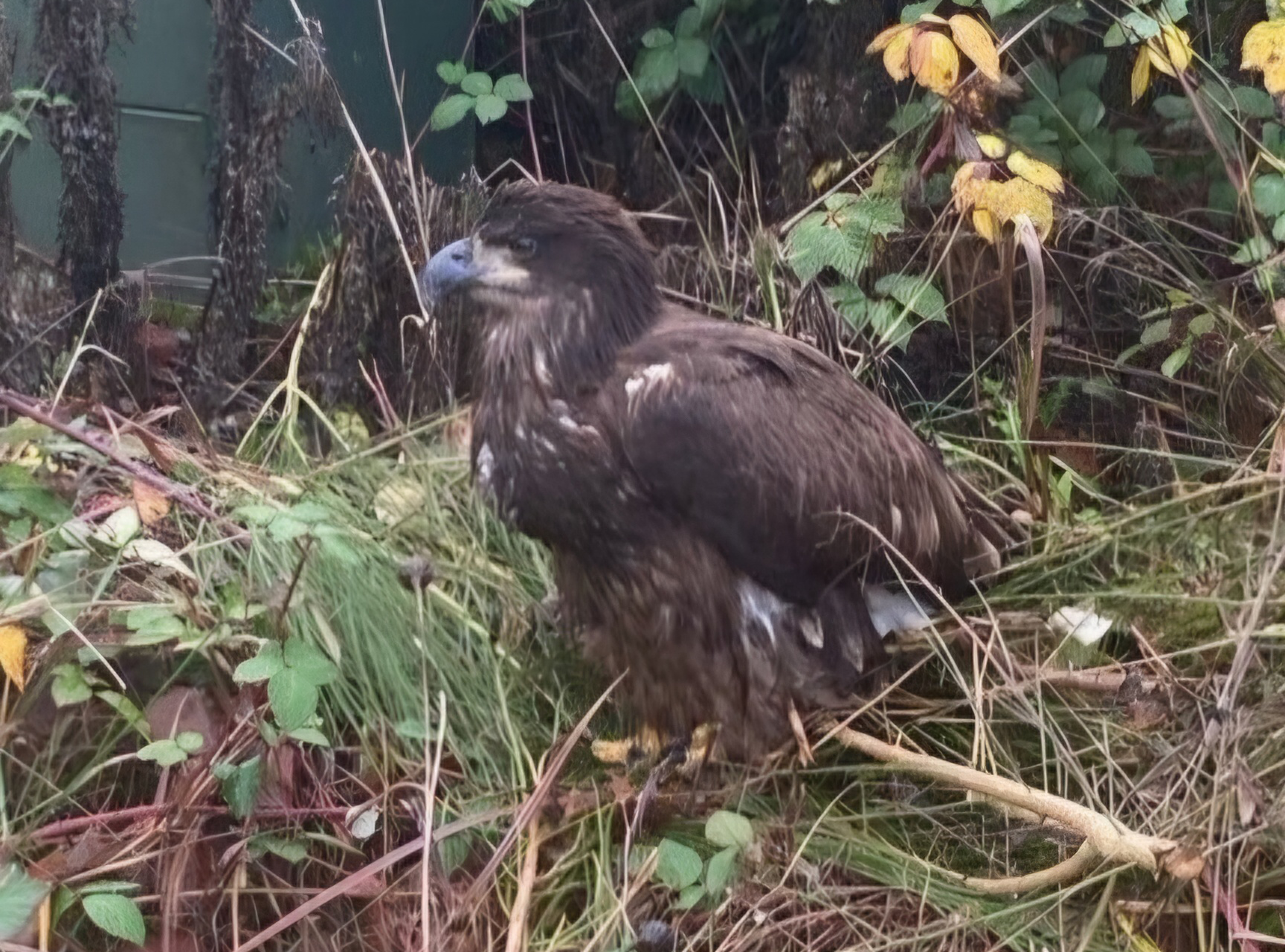
Researchers and volunteers apply a radio transponder to a woodcock (Scolopax minor) in Maine for a 2011 study. The device is similar to the one Snoopy carried from our Maine to North Carolina Timberlands.
When a little bird made its way from our timberlands in Maine to our timberlands in North Carolina a few years ago, our wildlife biologists were so captivated by this particular American woodcock (Scolopax minor) they named him Snoopy.
Snoopy made this monthlong, 730-mile journey as part of his annual fall migration. He started in an alder bog near Jackman, Maine, and settled on a 3,000-acre stand of 16-year-old loblolly pines near Elizabeth City, North Carolina.
“We discovered Snoopy after University of Maine researchers shared tracking data with our wildlife team,” says Andrew Brown, environmental manager for our timberlands in Virginia and the Carolinas. “It’s a great example of the biodiversity in working forests and how we proactively manage those forests for multiple benefits, including wildlife habitat.”
A map of the migration journey (bright green line) undertaken by "Snoopy" from Maine to North Carolina. Map courtesy of the Eastern Woodcock Migration Research Cooperative.
UNDERSTANDING WOODCOCK MIGRATION
Snoopy is part of the Eastern Woodcock Migration Research Cooperative, an international partnership interested in better understanding this species’ movements from its northern breeding areas to its southern wintering areas. The cooperative’s scientists are especially interested in identifying reasons for the bird’s declining numbers.
Researchers across the U.S. tag woodcocks with rump-mounted radio transmitters and capture daily migration data. Snoopy was tagged after University of Maine scientists requested access to an alder swamp on our property where woodcocks are known to thrive.
While woodcocks are currently classified as a species of ’least concern’ by the International Union for Conservation of Nature, populations are declining. Researchers suspect a contributing factor could be habitat loss in their southern ranges — especially the disappearance of farm fields, a preferred foraging location for woodcocks.
“Snoopy was living under the protective canopy of our pine forests in North Carolina and foraging on fallow farmland nearby,” Andrew says. “From Maine to North Carolina, his story helps illustrate the positive impact of responsible forest management.”
A researcher holds a woodcock from the 2011 study.
A 30-YEAR COMPARISON OF MAINE’S BIRDS
The woodcock study is just one of dozens of third-party research projects underway in our timberlands throughout North America at any given time.
More than a decade ago, Ray Ary, a harvest and transportation manager in Greenville, Maine, worked with local high school students to tag woodcocks for a similar study. More recently, he’s helped a consortium of scientists from Our Climate Common access our lands for a comprehensive study that compares bird populations on Maine timberlands today with a 1992-1994 baseline study.
Financially supported by Weyerhaeuser and others, the study examines how changes in forestry practices over the past 30 years have affected bird populations. It also explores how practices might continue to evolve to benefit North American birds, whose breeding populations have dropped by an estimated 3 billion individuals — some 30 percent — since the 1970s, mostly due to habitat loss.
Maine’s roughly 10 million acres of mostly privately owned forests are the largest contiguous, non-developed forestland east of the Mississippi and a globally significant bird area.
During a safety talk for the research team a few years ago, Ray chatted with John Hagan, the project’s lead scientist, who also led the original study in the ‘90s.
“We discussed how the most surprising and important findings from the earlier study were that clearcuts were not biological deserts,” Ray says. “While bird species that preferred mature forests left, those that preferred spaces and early vegetive growth — including species of concern — filled the niche.”
A woodcock nest rests on the forest floor. The long-beaked birds prefer to shelter and brood in forests and forage for earthworms and insects in open fields.
A “SHIFTING MOSAIC”
In the original 1990s paper, John and his coauthors called for commercial forest owners to think of their vast ownership as a shifting mosaic of bird habitats, where individual parcels were less important than a balance of age classes across entire landscapes.
Consequently, we adjusted our practices to incorporate smaller clearcuts and partial entries, where stands are selectively cut in the context of a bigger-picture perspective.
“When I talk to students — whether high schoolers or future foresters in college — I always stress the idea of taking a large-scale, long-term view of the landscape,” Ray says. “Of course, we take precautions for endangered or threatened species at the parcel level, but managing our forests as a large mosaic is one of the biggest changes in forestry over the past 30 years.”
It’s an approach that seems to work. This spring, John Hagan and his research collaborators published their final report, which showed that most bird species occurred at higher densities than 30 years ago. In several species, populations increased in Maine while declining elsewhere in North America. Though some species of concern did decline, commercial forestry didn’t appear to be a significant contributing factor.
The American woodcock is found throughout our timberlands, from Maine to North Carolina and across the U.S. South. (Photo credit: Charles Fergus)
NEW KNOWLEDGE, NEW APPROACHES
In the report, John said bird conservation in Maine has improved over the decades, with the “glass being 80 percent full.” And while that’s good news, our Maine Timberlands team will take the opportunity to learn from the findings and possibly adjust our practices to further improve bird conservation in our forests.
“We need to be sure that any changes in our practices have a net benefit for the ecosystem as a whole,” Rays says. “We always seek to improve, and we’ll collaborate with our wildlife biologists and the scientific community to understand the research to do so. After all, that’s why we support science: to expand our knowledge, test our assumptions and hone our practices.”


